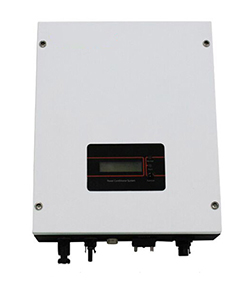Stability of output voltage
 In the photovoltaic system, the electric energy generated by the solar cell is first stored in the battery, and then converted into 220V or 380V alternating current through the inverter. However, the battery is affected by its own charge and discharge, and its output voltage varies widely. For example, for a nominal 12V battery, its voltage value can vary between 10.8 and 14.4V (exceeding this range may cause damage to the battery). For a qualified solar inverter, when the input voltage changes within this range, the change of the steady-state output voltage should not exceed 5% of the rated value, and when the load changes suddenly, the output voltage deviation should not exceed ±10% of rated value.
In the photovoltaic system, the electric energy generated by the solar cell is first stored in the battery, and then converted into 220V or 380V alternating current through the inverter. However, the battery is affected by its own charge and discharge, and its output voltage varies widely. For example, for a nominal 12V battery, its voltage value can vary between 10.8 and 14.4V (exceeding this range may cause damage to the battery). For a qualified solar inverter, when the input voltage changes within this range, the change of the steady-state output voltage should not exceed 5% of the rated value, and when the load changes suddenly, the output voltage deviation should not exceed ±10% of rated value.
Waveform Distortion of Output Voltage
For sine wave inverters, the maximum allowable waveform distortion (or harmonic content) shall be specified. Usually expressed as the total waveform distortion of the output voltage, its value should not exceed 5% (single-phase output allows l0%). Since the high-order harmonic current output by the inverter will generate additional losses such as eddy current on the inductive load, if the waveform distortion of the inverter is too large, it will cause serious heating of the load components, which is not conducive to the safety of electrical equipment and seriously affects the operating efficiency of system.
Rated output frequency
For loads including motors, such as washing machines, refrigerators, etc., because the optimal frequency of the motor is 50Hz, the frequency is too high or too low, which will cause the equipment to heat up and reduce the operating efficiency and service life of the system. The output frequency should be a relatively stable value, usually the power frequency 50Hz, and its deviation should be within 1% under normal working conditions.
Load power factor
It characterizes the ability of the inverter to carry inductive or capacitive loads. The load power factor of the sine wave inverter is 0.7 to 0.9, and the rated value is 0.9. In the case of a certain load power, if the power factor of the inverter is low, the required capacity of the inverter will increase, which will increase the cost and increase the apparent power of the AC circuit of the photovoltaic system. As the current increases, the losses will inevitably increase, and the system efficiency will also decrease.
Inverter efficiency
The efficiency of the solar inverter refers to the ratio of the output power to the input power under the specified working conditions, expressed as a percentage. In general, the nominal efficiency of a solar inverter refers to pure resistance load or under 80% load efficiency. Since the overall cost of the photovoltaic system is high, the efficiency of the photovoltaic inverter should be maximized, the system cost should be reduced, and the cost performance of the photovoltaic system should be improved. At present, the nominal efficiency of mainstream inverters is between 80% and 95%, and the efficiency of low-power inverters is required to be no less than 85%. In the actual design process of the photovoltaic system, not only should high-efficiency inverters be selected, but at the same time, the system should be reasonably configured to make the photovoltaic system load work near the optimal efficiency point as much as possible.
Rated output current
It indicates the rated output current of the inverter within the specified load power factor range. Some inverters give the rated output capacity, which is expressed in VA or kVA. The rated capacity of the inverter is when the output power factor is 1, the rated output voltage is the product of the rated output current.
